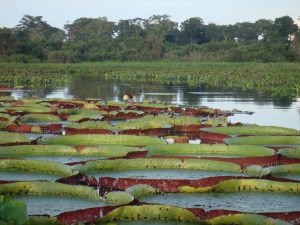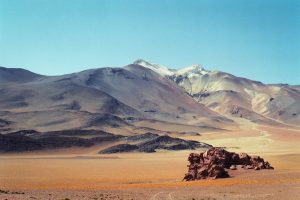5.18: Latin America and the Caribbean (LACAR)- Overview
- Page ID
- 73629
In the various essays about Latin America and the Caribbean (LACAR) in this textbook, there are many facts presented and many ways of life understood. After reading the textbook, students or other readers should know and understand many things about LACAR. Also, as has been stated, it is not the point of this textbook to attempt to convey every possible bit of knowledge about LACAR. However, there are a few basics about Latin America and the Caribbean that the reader should know, whether picked up in previous chapters or not.
As explained in Chapter 63, delineating this region, let’s recall that we are defining this region based mainly on three factors – Americas, Latin languages, and contiguity. Accepting those factors, what else should we know about the region, in general?
Latin America and the Caribbean essentially is all of the Western Hemisphere, except for the two huge pieces, the United States and Canada, which comprise North America. South America is clearly defined by its physical landscape as a continent. As highlighted in Chapter 77, Brazil is the major country of South America. Similarly, Mexico is the major player in Central or Middle America, the mainland section of countries between North and South America. The Caribbean region consists of the numerous islands that create the borders of the Caribbean Sea. These Caribbean islands are categorized largely by areal size – Greater and Lesser Antilles; even so, there isn’t really a dominant island among the set.
The modern history of LACAR is heavily affected by colonialism. Mainland territories mostly were controlled by Spain and Portugal, while island colonies also showed British, Dutch, and French presence (plus a few mainland locations, such as British Honduras (now Belize) and Suriname. Colonial control throughout the region established primary sector economics, so that large-scale farming and mining of natural resources were routine and widespread. These economies greatly benefitted the colonial powers, while failing to produce wealth among the local populations. The term “banana republic” was coined to refer to countries of backwards politics and colonial economics. Although colonial control often ended in the 1960s and indeed most of LACAR consists of independent countries, raw materials such as copper in Chile and oil in Venezuela are still crucial to economic success, while agriculture even expands into cleared former forests of the Amazon region. Trade associations such as NAFTA and Mercosur offer means for equitable and efficient import and export flows in and beyond the region. Due to Spanish (and Portuguese in Brazil) influence throughout the region, Spanish language and Christian religion are dominant cultural elements.
Throughout LACAR and before European exploration, there were large populations of Amerindians throughout the region. Like the Inca, Maya, and Aztec nations, several of these populations have well-known histories and relics. The Mayan languages still are spoken by about six million people in Honduras, Belize, and Mexico’s Yucatan Peninsula. Perhaps as many as ten million people speak a Quechuan language, primarily in Peru, where it is the language of one-quarter of the population. Famous anthropologic sites such as Machu Picchu in Peru, Mayan pyramids in Mexico, and Nazca lines (geoglyphs) also in Peru point to historically vibrant societies.
Modern LACAR is highly urbanized, matching North America as the most urban regions in the world at over 80% of the populations living in urban areas. LACAR has accomplished this in a hurry, moving to cities in a rapid pace, thereby catching up with North America. Often LACAR is considering to be in the developing world on a par with Asia and Africa. In fact, LACAR’s urban percentage nearly doubles that of Africa and far outpaces that of Asia. In development, except for Haiti (169th out of 189 countries in the Human Development Index – HDI), Latin American and Caribbean countries compare well to Asian countries and usually are far ahead of African countries. In HDI, Peru and Ecuador match China; Mexico, Brazil, and Colombia are level with Thailand; Costa Rica and Panama are there with Iran; and Chile at #42 trails only Japan, Israel, and South Korea (and special cases of Qatar, Singapore, and Hong Kong) among Asian countries.
South America features two major landforms that comprise vast areas. The Andes Mountains stretch the length of the continent, running along the western edge. These mountains dominate all of Chile. The Amazon River and corresponding basin and rainforest span a vast expanse of northern Brazil, while with its tributaries also branching into several neighboring countries. Broad grasslands reach across Colombia and Venezuela (the Llanos) and Argentina (the Pampas).

The Pantanal, the world’s largest tropical wetland, is mainly in Brazil, but crosses borders into Bolivia and Paraguay.

Chile’s Atacama Desert is the driest desert in the world.
Modern LACAR displays rich cultures, diverse in arts (dance and music) and sports (soccer, especially). Reggae music in Jamaica and the tango dance in Argentina are two of many examples of popular and talented cultural elements in the region.
Overall, LACAR spans the tropical regions of the Western Hemisphere, but continues southward to include countries like Argentina in South America. It is a region diverse in landscape, climate, culture, and economy.
Did you know?
There are four thousand varieties of potatoes in Peru.
Chile is one of the world’s top producers of wine.
Guinea pigs are eaten in Peru and parts of Ecuador and Colombia. Statistically, guinea pigs consume less food per pound of meat yielded than cattle do, so perhaps it is more efficient to raise guinea pigs than it is to raise cattle. Don’t argue that point in Argentina and Brazil where cattle ranching is a huge agricultural industry.
Cited and additional bibliography:
Milani, Raphael. 2008. Pantanal. https://tinyurl.com/pantanal2008. Attribution 2.0 Generic (CC BY 2.0).
Morgan, Jen. 2011. Atacama Desert. https://tinyurl.com/atacama2011. Attribution-NoDerivs 2.0 Generic (CC BY-ND 2.0).


